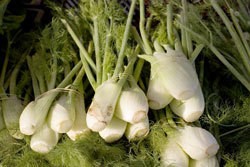
Selecting High-Quality Fennel:
- Leaves: Immature fennel leaves should be harvested in the morning after the dew has dried. Look for dark green leaves, free of disease and damage from insects.
- Seeds: Harvest seed after it has started to dry within the pod, but before the pod has fully opened.
Preparing for Freezing:
- Leaves: Fennel leaves will lose their crisp texture during freezing but will retain good flavor and be suitable for cooked dishes. Gently wash fresh leaves and blot dry. Strip leaves off stalks and either chop leaves or freeze them whole.
- Seeds: It's better to dry fennel seeds than freeze them. Lay them on a cookie sheet tray in direct sun for 4 to 6 hours to dry. Alternatively, place them in an oven heated to 120ºF for 4 to 6 hours. Store in plastic bags or airtight containers until used.
Best Freezing Method(s):
Suitable Packaging:
Freezer containers should be moisture and vapor resistant and should not be prone to cracking or breaking at low temperatures. Containers should provide protection against absorbing flavors or odors and should be easy to label. Suitable packaging for freezing fennel includes freezer-grade plastic bags, rigid plastic containers or glass containers and ice cube trays.
Maximum Storage Time:
Store dried fennel seeds and leaves in the pantry for 6 months. Store frozen fennel leaves (including paste and cubes) for 1 year or more at 0ºF.
Thawing:
Bagged leaves, pastes and cubes can all be removed from the freezer and added directly to dishes while cooking.
Tips & Shortcuts:
Try drying fennel leaves in the microwave by placing a single layer of leaves between paper towels and drying them for 1 or 2 minutes. Be careful not to over dry or the leaves will taste burnt and may even catch on fire. Some microwaves should not be used for this, so consult with your microwave manufacturer before drying herbs in your microwave.
